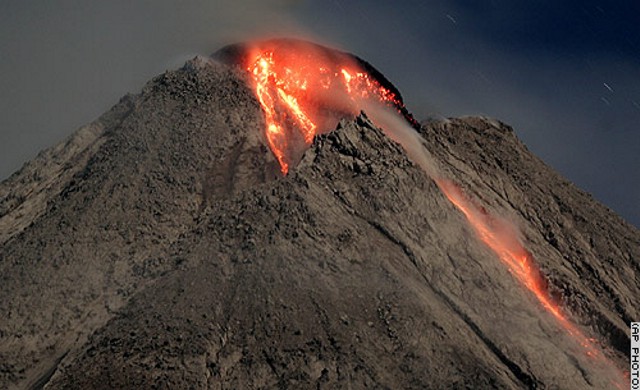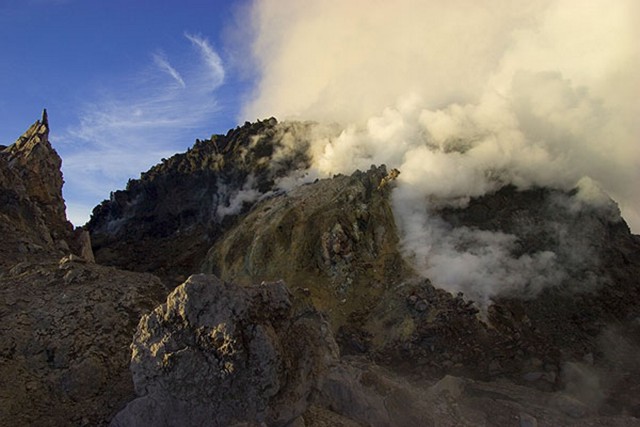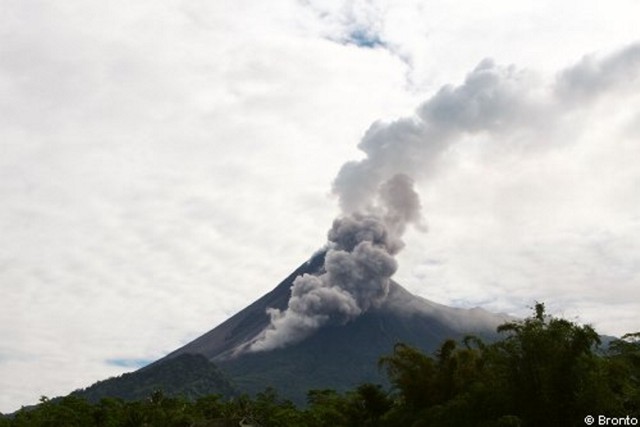Report on Merapi (Indonesia) — October 2008
Bulletin of the Global Volcanism Network, vol. 33, no. 10 (October 2008)
Managing Editor: Richard Wunderman.
Merapi (Indonesia) Lava dome growth with intermittent ash plumes and rock avalanches
Please cite this report as:
Global Volcanism Program, 2008. Report on Merapi (Indonesia) (Wunderman, R., ed.). Bulletin of the Global Volcanism Network, 33:10. Smithsonian Institution. https://doi.org/10.5479/si.GVP.BGVN200810-263250
Merapi
Indonesia
7.54°S, 110.446°E; summit elev. 2910 m
All times are local (unless otherwise noted)
Our last report on Merapi (BGVN 32:02) described vigorous dome growth during March-July 2006. The increasingly unstable summit was the scene of numerous pyroclastic flows, avalanches, and volcanic earthquakes. According to the Center of Volcanology and Geological Hazard Mitigation (CVGHM), Merapi's long-term dome growth continued at low to modest levels during the rest of 2006 and early 2007.
Activity in May 2006 included dome growth (figures 35 and 36) and pyroclastic flows (figure 37). According to CVGHM, as a result of decreasing activity, the Alert Level was lowered to 3 (on a scale of 1-4) for all areas on 17 July 2006 and to Level 2 on 3 August 2006. Nearly continuous thermal anomalies were measured by the MODIS/MODVOLC satellite system during the period 14 May-5 September 2006, and small anomalies were noted on 29 November 2006 and 5 January 2007. No thermal anomalies for Merapi have been measured by MODIS since 5 January 2007. The Darwin Volcanic Ash Advisory Center (VAAC) noted a plume to 6.1 km altitude drifting NE on 19 March 2007 (table 19).
 |
Figure 35. Incandescent blocks stream down the growing lava dome on 15 May 2006. Courtesy of Discover Indonesia Online (Associated Press photo). |
 |
Figure 36. Newly extruded dome lava on the summit of Merapi seen from the N side on 21 May 2006. Courtesy of Tom Pfeiffer (Volcano Discovery). |
 |
Figure 37. Merapi erupting on 23 May 2006 as seen from Cangkringan, near Yogyakarta. The image captured a pyroclastic flow. Courtesy of Discover Indonesia Online. |
Table 19. Ash plumes and other events associated with Merapi between 5 July 2006 and 15 November 2008. Distances given under "Other events" represent maximum distances observed. Plume altitudes through 1 August 2006 were calculated from CVGHM information; subsequent plume altitudes were reported by the Darwin VAAC. Courtesy of CVGHM, Darwin VAAC, and various newspaper articles.
| Date | Plume altitude | Other events |
| 05 Jul-11 Jul 2006 | 4 km | -- |
| 12 Jul-18 Jul 2006 | 4 km | Lava flows, 2 km SE |
| 19 Jul-25 Jul 2006 | 3.4 km | Daily lava flows, 1.5 km SE. |
| 26 Jul-01 Aug 2006 | 3.4 km | Incandescent rock avalanches, 2 km SE. |
| 02 Aug-04 Aug 2006 | 6.1 km | Rockfalls, 1 km SE. |
| 10 Oct 2006 | -- | Incandescent material, 1 km. |
| 20 Nov 2006 | -- | "Hot clouds," 3 km. |
| 19 Mar 2007 | 6.1 km | -- |
| 23 May-29 May 2007 | -- | Incandescent material and "hot clouds," 1 km SE. Ashfall 16 km W. |
| 09 Aug 2007 | 4.6 km | -- |
| 19 May 2008 | 11.6 km | -- |
Geological Summary. Merapi, one of Indonesia's most active volcanoes, lies in one of the world's most densely populated areas and dominates the landscape immediately north of the major city of Yogyakarta. It is the youngest and southernmost of a volcanic chain extending NNW to Ungaran volcano. Growth of Old Merapi during the Pleistocene ended with major edifice collapse perhaps about 2,000 years ago, leaving a large arcuate scarp cutting the eroded older Batulawang volcano. Subsequent growth of the steep-sided Young Merapi edifice, its upper part unvegetated due to frequent activity, began SW of the earlier collapse scarp. Pyroclastic flows and lahars accompanying growth and collapse of the steep-sided active summit lava dome have devastated cultivated lands on the western-to-southern flanks and caused many fatalities.
Information Contacts: Center of Volcanology and Geological Hazard Mitigation (CVGHM), Jalan Diponegoro 57, Bandung 40122, Indonesia (URL: http://vsi.esdm.go.id/); Darwin Volcanic Ash Advisory Centre (VAAC), Bureau of Meteorology, Northern Territory Regional Office, PO Box 40050, Casuarina, NT 0811, Australia (URL: http://www.bom.gov.au/info/vaac/); Hawai'i Institute of Geophysics and Planetology (HIGP) Thermal Alerts System, School of Ocean and Earth Science and Technology (SOEST), University of Hawai'i, 2525 Correa Road, Honolulu, HI (URL: http://hotspot.higp,hawaii.edu); Discover Indonesia Online (URL: http://www.indahnesia.com/); Tom Pfeiffer, Volcano Discovery (URL: http://decadevolcano.net/).

